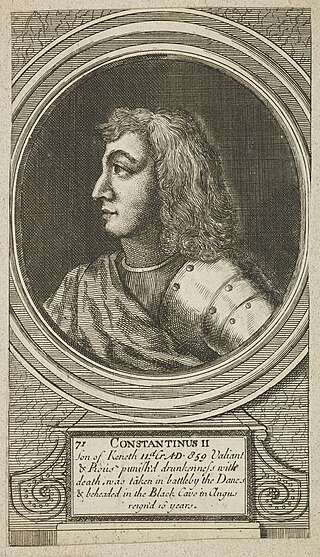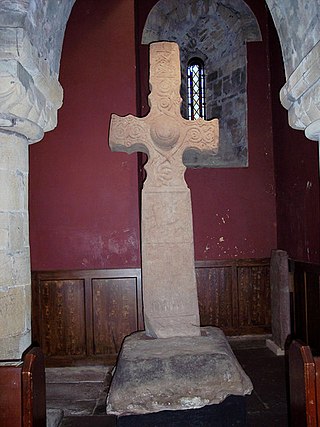Related Research Articles

Áed mac Cináeda was a son of Cináed mac Ailpín. He became king of the Picts in 877, when he succeeded his brother Constantín mac Cináeda. He was nicknamed Áed of the White Flowers, the wing-footed or the white-foot.

Causantín mac Cináeda was a king of the Picts. He is often known as Constantine I in reference to his place in modern lists of Scottish monarchs, but contemporary sources described Causantín only as a Pictish king. A son of Cináed mac Ailpín, he succeeded his uncle Domnall mac Ailpín as Pictish king following the latter's death on 13 April 862. It is likely that Causantín's reign witnessed increased activity by Vikings, based in Ireland, Northumbria and northern Britain. He died fighting one such invasion.

Causantín mac Áeda was an early King of Scotland, known then by the Gaelic name Alba. The Kingdom of Alba, a name which first appears in Constantine's lifetime, was situated in modern-day Northern Scotland.
Domnall mac Ailpín, anglicised sometimes as Donald MacAlpin and known in most modern regnal lists as Donald I, was King of the Picts from 858 to 862. He followed his brother Kenneth I to the Pictish throne.
Kenneth MacAlpin or Kenneth I was King of Dál Riada (841–850), and King of the Picts (843–858) of likely Gaelic origin. He inherited the throne of Dál Riada from his father Alpín mac Echdach, founder of the Alpínid dynasty. Kenneth I conquered the kingdom of the Picts in 843–850 and began a campaign to seize all of Scotland and assimilate the Picts, for which he was posthumously nicknamed An Ferbasach. He fought the Britons of the Kingdom of Strathclyde and the invading Vikings from Scandinavia. Forteviot became the capital of his kingdom and Kenneth relocated relics, including the Stone of Scone from an abandoned abbey on Iona, to his new domain.

Cináed mac Maíl Coluim was King of Alba (Scotland) from 971 to 995. The son of Malcolm I, he succeeded King Cuilén on the latter's death at the hands of Rhydderch ap Dyfnwal in 971.
Cináed mac Duib, anglicised as Kenneth III, and nicknamed An Donn, was King of Alba (Scotland) from 997 to 1005. He was the son of Dub. Many of the Scots sources refer to him as Giric son of Kenneth son of Dub, which is taken to be an error. An alternate explanation is that Kenneth had a son, Giric, who ruled jointly with his father.
Constantine, son of Cuilén, known in most modern regnal lists as Constantine III, was king of Alba (Scotland) from 995 to 997. He was the son of King Cuilén. John of Fordun calls him, in Latin, Constantinus Calvus, which translates to Constantine the Bald. Benjamin Hudson notes that insular authors from Ireland and Scotland typically identified rulers by sobriquets, noting for example the similarly named Eugenius Calvus, an 11th-century King of Strathclyde.

Domnall mac Causantín, anglicised as Donald II, was King of the Picts or King of Alba in the late 9th century. He was the son of Constantine I. Donald is given the epithet Dásachtach, "the Madman", by the Prophecy of Berchán.

Eochaid ab Rhun was a ninth-century King of Strathclyde, who may have also been King of the Picts. He was a son of Rhun ab Arthgal, King of Strathclyde, and descended from a long line of British kings. Eochaid's mother is recorded to have been a daughter of Cináed mac Ailpín, King of the Picts. This maternal descent from the royal Alpínid dynasty may well account for the record of Eochaid reigning over the Pictish realm after the death of Cináed's son, Áed, in 878. According to various sources, Áed was slain by Giric, whose ancestry is uncertain and who then proceeded to usurp the Alban throne.
Óengus mac Fergusa was king of the Picts from 820 until 834. In Scottish historiography, he is associated with the veneration of Saint Andrew, the patron saint of Scotland, although this has not been proven.

Causantín or Constantín mac Fergusa was king of the Picts, in modern Scotland, from 789 until 820. He was until the Victorian era sometimes counted as Constantine I of Scotland; the title is now generally given to Causantín mac Cináeda. He is credited with having founded the church at Dunkeld which later received relics of St Columba from Iona.

Giric mac Dúngail, in modern English his name is Gregory or Greg MacDougal and nicknamed Mac Rath, was a king of the Picts or the king of Alba. The Irish annals record nothing of Giric's reign, nor do Anglo-Saxon writings add anything, and the meagre information which survives is contradictory. Modern historians disagree as to whether Giric was sole king or ruled jointly with Eochaid, on his ancestry, and if he should be considered a Pictish king or the first king of Alba.
De Situ Albanie is the name given to the first of seven Scottish documents found in the so-called Poppleton Manuscript, now in the Bibliothèque nationale de France, Paris. It was probably written sometime between 1202 and 1214, in the reign of the William the Lion, by a French-speaking resident of Scotland, as an introduction to the compilation.
The Chronicle of the Kings of Alba, or Scottish Chronicle, is a short written chronicle covering the period from the time of Kenneth MacAlpin until the reign of Kenneth II. W.F. Skene called it the Chronicle of the Kings of Scots, and some have called it the Older Scottish Chronicle, but Chronicle of the Kings of Alba is emerging as the standard scholarly name.
The Poppleton manuscript is the name given to the fourteenth-century codex probably compiled by Robert of Poppleton, a Carmelite friar who was the Prior of Hulne, near Alnwick. The manuscript contains numerous works, such as a map of the world, and works by Orosius, Geoffrey of Monmouth and Gerald of Wales. It is now in the Bibliothèque Nationale, Paris.
Conall mac Taidg was a king of the Picts from 785 until 789. Very little is recorded of Conall. He is mentioned twice by the Irish annals, the most reliable source for the history of northern Britain in the years around 800. He also appears in later king lists.

The origins of the Kingdom of Alba pertain to the origins of the Kingdom of Alba, or the Gaelic Kingdom of Scotland, either as a mythological event or a historical process, during the Early Middle Ages.
Taran son of Ainftech was a King of the Picts from 693 until 697, according to the Pictish king-lists. His name is the same as that of the Gaulish thunder-god, Taranis.
References
- ↑ Skene, op. cit., p. 151, quoted in A.O. Anderson, Early Sources, pp. 364–365. The untranslated texts are given by M.O. Anderson, pp. 264ff.
- ↑ The surviving lists and their origins and relationships are discussed extensively by Marjorie Ogilvie Anderson.
- ↑ The Chronicle of Melrose account, from Skene, op. cit, pp. 22 & 224, is quoted in A.O. Anderson, Early Sources, p. 368.